Tracing the Paradigms of Corporate Communication
(A Study of Corporate Communication in the Private Sector withinIndia)
Kirti Sundram[1]
Abstract:
Rapid transformations in the market landscape has forced organisationsglobally to shift gears in multiple way. These changes have had an impact on corporate communication practices, as it plays an essential role in creating value for an organisation. With the increased importance of Communication in business, Public Relations (P.R.) has changed fundamentally in the private sector. P.R. has transformed itself and rechristened as Corporate Communication.
The blurring of the lines between consumer branding and company reputation, the significance of leadership from the top of the organisation, and the need to interact through digital and social media are among the significant problems that corporate communicators will face in the coming years.
The purpose of this research is to comprehend the role of the individual or organisation in determining the function and/or process and Corporate Communication in the private sector. The study looks at how the Corporate Communication function has evolved through time.
This research takes a quantitative approach. An administered survey of 50 Corporate Communication professionals with at least ten years of experience in public relations conducted across age groups, gender, and income scales concludes that the organisation determines the change and process of communication within the private sector and is more influential than the individual in determining the said change and process.
Keywords:Corporate Communication, Public Relations, Private Sector, Consumer Branding,Corporate Reputation
Introduction:
Corporate Communication is used for marketing a product, service, or organisation. It can also be used to convey information within the organisation or to address legal issues. According to Joep Cornelissen (2001), the best way to describe corporate Communication is to examine how the role has evolved in organisations.
In India, the globalisation of the economy in the 1990s gave public relations its proper place. Foreign direct investment opportunities expanded with the introduction of multinational corporations in the early 1990s, particularly with the deregulation of industries.
According to Steyn (2000), any private-sector organisation has now begun to consolidate a variety of communications disciplines into a single department so that practitioners’ knowledge and skills can be shared, and corporate Communication is viewed as a self-contained and significant function within the organisation. The traditional roles of manager and technician in corporate communications have recently given way to a third – that of a “strategist.”
With the rising importance of Communication in business, public relations (P.R.) in the commercial Sector has altered radically. Public relations has evolved into Business Communication.
The blurring lines between consumer branding and corporate reputation, the significance of leadership from the top of the organisation, and the need to interact through digital and social media are just a few of the significant problems that corporate communicators will face in the coming years. The corporate communications landscape is rapidly shifting.
Research Objectives
- To understand the changing landscape of Corporate Communications over the year
- To identify key factors contributingto the changing paradigms of the function
- To assess whether Corporate Communication is a part of marketing communication or a standalone entity
- To identify if the individual or the organization is determining the function and process of Corporate Communication
- Analyse whether the change is being reflected in the KRAs of the Corporate Communication professionals
Research Questions
RQ1: How has Corporate Communications function evolved over the years?
RQ2: What role does an individual play in determining the Corporate Communication function and process?
RQ3: What role does an organization play in determining the Corporate Communication function and process?
RQ4: How has Corporate Communication interspersed into Marketing Communication?
RQ5: What is the impact on Crucial Responsibility areas (KRAs) with the changing paradigms of the function?
Literature Review:
Corporate Communications in India
In India, the globalisation of the economy in the 1990s gave public relations its proper place. Foreign direct investment opportunities expanded with the introduction of multinational corporations in the early 1990s, particularly with the deregulation of industries. As businesses grew more competitive, they felt obligated to improve their reputation to access new markets and consumers. As a result, the country’s number of public relations and advertising agencies has skyrocketed. The nearly century-old field of public relations has gone a long way.
Several academics have examined the growth and progress of public relations in India from various perspectives. JM Kaul (1992) describes four stages in the history of public relations: the early stage, the stage of conscious public relations, the third stage of public relations, and lastly, Professionalism in public relations. Professional public relations is thought to have begun in the pre-independence era when the British government needed to gain Indian support for World War I. It was also the emergence of family-owned corporate houses such as Tata and Birla.
As the marketplace and technology, customers’ preferences and behaviour are changing; many private-sector businesses are now combining a variety of communications specialities into a single department. In corporate communications, the traditional roles of manager and technician have recently given way to a third – the role of “strategist” (Steyn, 2000).
Role of Corporate Communication in the Private Sector
Organisational and corporate identity: Identity can be approached in two ways:
Corporate Reputation: Organisations’ reputations are general assessments of their stakeholders. These are stakeholders’ collective perceptions of an organisation’s ability to meet their expectations, whether they want to buy the company’s products, work for it, or invest in its shares. (F. Charles, 1996, Reputation: Achieving Value from Business Image)
Crisis Communications: Crisis communication is sometimes regarded as a sub-speciality of public relations, to protect and defend an individual, corporation, or organisation facing a public challenge to its reputation. These challenges may occur in the shape of an investigation by a government agency, a criminal allegation, a media enquiry, a shareholders lawsuit, a violation of environmental regulations, or any of a number of other scenarios concerning the legal, ethical, or financial status of the company.
Internal/Employee communication: As the scope of communication expands, many organisations establish an employee relations (E.R.) function with specialised personnel to manage the many media via which top executives can interact among themselves and with the rest of the organisation.
Investor Relations: Companies that openly trade shares on a stock market use the investor relations (I.R.) function. The I.R. specialist’s role in such firms is interacting with current and potential financial stakeholders, such as retail investors, institutional investors, and financial analysts.
The Role of Corporate Communication Professional in the Private Sector Today

Organogram of Contemporary Corporate Communications Department in Private Sector (Corporate Communications organogram at Siemens)
The Changing Dynamics of Corporate Communication
According to Edgar Schein (2007), organisations do not create a culture in a single day but over time as individuals go through numerous changes, respond to the external environment, and confront issues. They regularly apply what they’ve learnt from previous experiences, thereby shaping the workplace culture. Similarly, the Corporate Communication function has evolved gradually. (2013) (Dalia Susniene) A new management field – corporate Communication – is being demonstrated in global management practice.
Today’s organisations’ surroundings and internal operations are highly complex and dynamic, resulting in constant change. A corporation must respond rapidly when faced with problems and evolution in the twenty-first century. To be aware and effective, members of an organisation require clear, relevant, and full information. Changes in the communication system and processes have also resulted from organisational change including:
- The emergence of Communications as a unified function:
- Marketing Communication integration into Corporate Communication
- Incorporation of Investor communications into Corporate Communication
- Corporate lobbying integration in Corporate Communications
- The rise of the CCO
- Rise of social media
Theoretical Framework
Enactment Theory
According to Weick (1988), enactment relates to the idea that when humans act, they construct structures and events and set them in motion. Weick uses this term to describe managers’ or employees’ “sensemaking.” He also discusses how individuals may set ‘limitations’ on the system to avoid issues or unpleasant interactions.
The research paper examines the structure of a private sector organisation’s corporate communication function and the integration of other aspects within corporate communication. The most important predictor of informal and formal networks is communication structure. The study looks at the function of individuals/organisations in the modern corporate communication paradigm and organisational development.
Research Method
The quantitative method of generating data was used in this research. A mail survey was conducted across 50 corporate communication professionals with a minimum of 10 years of professional experience in P.R. These also included respondents who have been an old hand in the profession and have diversified into other facets of the profession such as setting up their own P.R. agency or being independent consultants for private sector companies.
The survey was initiated to understand whether or not Corporate Communication has changed over the years. The survey questionnaire also studied the determinants of this change and the amendments in the KRAs and remuneration of Corporate Communication professionals.
Sampling Design
The researcher has used non – probability sampling technique in this study as no mathematical guidelines are followed in selecting each sample. The sample was selected using purposive and handpicked techniques, as we chose the respondents who fall into a particular category of employed corporate communication professionals. There are 30 males and 20 females who participated in this survey.
Data Collection Tool
The researcher used an unstructured questionnaire for the survey consisting mainly of close-ended questions anda few open-ended ones.
Data Processing
A pilot study with 50 corporate communication professionals was done to check the validity of the questionnaire. The pilot study results indicated no discrepancy in the questionnaire; hence, the same questionnaire was considered for the final study.
The questionnaire was drafted to study the journey of Corporate Communication in the private sector and the factors leading to its growth as a function. The researcher received 50 responses.
Data Analysis
The data wascoded into SPSS software. Crosstabs were done between various responses received from the respondents. Percentages were studied along the graphs of the crosstabs.
The following is an analysis of the data generated by administering surveys across a wide range of respondents. The data was generated by using a sample size of 50 Corporate Communication professionals, out of which 300 were male and 20o female from the age groups of 23-30 years, 31-35 years, 36-40 years, and 41 years & above and from the income group of Rs. 10 lakhs per annum (L.P.A.): 10-15 L.P.A., 16-20 L.P.A., 21- 25 L.P.A. and 26 L.P.A.& above.
The data was generated to determine if the individual or the organization is determining the function and/or process of Corporate Communication in the private sector and understand the changes the Corporate Communication function has undergone over the years.
5.1 Have you been a Corporate Communication professional throughout your career? If no, then what did you diversify from?
Graph 5.1 (a)
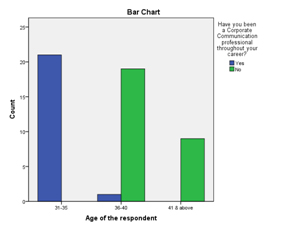
The above graph indicates that 42% of the respondents who belong to the age group of 31-35 years have been a Corporate Communications professional throughout their career, whereas 40% of the respondents from the age group of 36-40 years have not been a Communications professional throughout their career. 18 % of the respondents who fall into the category of 41 years & above have also diversified from other professions into Corporate Communications. The above graph backs the fact that people who have started young as Communications professionals have been in the field throughout since the inception of Corporate Communications if reasonably new. In contrast, higher age groups have diversified into this field in their career paths in later stages.
5.2 Key Responsibility Areas (KRA) of the Corporate Communication team
100% of respondents have well-definedKRAs for each member of their team. The graph also reinforces that the Communication team has a well-defined process chart. And therefore suggests that Corp Comm is a well-defined function in the present-day corporate sector.
Studies have shown that KRA’s are critical to the performance of Corporate Communications function. The purpose of Corporate Communication is to assist with this process by providing communication support to the rest of the organization. The ability of Communication may be measured by incorporating Communication into the performance measurement model of the organization. This can be done by developing KRAs for Communication that is represented on every level of the organization. (Shackleton, Celeste, 2007)
Graph 5.2
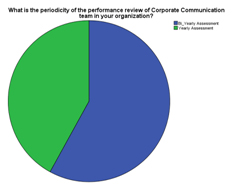
58% of the respondents highlight that they undergo a performance review process viaabi-yearly assessment system, whereas 42% go through a yearly assessment review process. This indicates that the performance monitoring system for Corporate Communication professionals is extremely competitive and organized.
5.3 Functions of Corporate Communications

96% of the total respondents in the above graph say that they have also commissioned a P.R. agency over and above the communication department.
Studies show that companies need P.R. agencies as an external interface of the organization with the outside world apart from the in-house communication team and add more value to their corporate reputation program.
5.4 Are the views of the Corporate Communication department solicited by the management in case of any crisis or important event? Is the Corporate Communication head a part of the senior management team of your organization?
Graph 5.4 (a)

56% of the respondents who belong to the income group of 26 lakhs per annum (L.P.A.) & above indicate that the views of the communications team are sometimes solicited by the management case of an ay important event or crisis. 42% of the respondents belonging to the income group of 16-20 L.P.A. feel that the views of the communications team are constantly solicited in case of any crisis or significant event.
From the above findings, we observe that the respondents who have said that the opinion of the communication teams is always/sometimes asked for either belong to the senior level communications professionals or the beginners in the field.The researcher also observes that the senior management team briefs the communications department reasonably regularly on the company’s communication objectives.
Graph 5.4 (b)
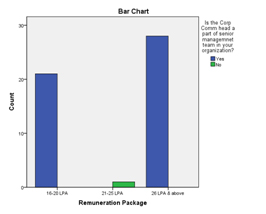
The above-mentioned graph suggests that 56% of the respondents who belong to the income group of 26 L.P.A.& above and 42% of the respondents belonging to 16-20 L.P.A. have said that the communications head is a part of the senior management team of their organization.
The Korn Ferry’s Global Corporate Affairs survey of the senior-most communications executives at U.S. companies in the Fortune 500 show that Fortune 500 CCOs are taking broader leadership roles in their organizations beyond the traditional communications function.
The researcher observes that most of the respondents who have said that the communications head belongs to the senior management also occupy a senior role with the communications team of their organization. Studies (Argenti, 2013, p. 54) have also proved that the C.E.O. should be the person most involved in developing the overall strategy for communications and delivering consistent messages to constituencies.
5.5 On a scale of 10, rate the importance of Corporate Communication within your organization from the perspective of senior management?

98% of the total respondents, as indicated in the graph above, have rated 6-8 points on the scale of 10 to the importance of Corporate Communication within their organization from the perspective of senior management.
5.6 Organizational traits which affect the growth of Corporate Communications the most

The findings of the above graph indicate that 96% of the total respondents feel that management’s outlook affects the growth of Corporate Communication the most. Only 2% of the respondents think that the need for the function and resource availability affects the development of the communications function.
- In the current scenario, who, according to you, determines the function and process of Corporate Communication? Who do you think had led the change in this function?
Graph 5.7 (a)

The above graph suggests that 56% of the total respondents feel that the senior management/organization determines the function and process of corporate Communication. However, 42% of the respondents thinkit’s both the individual (corporate Communication professional) and the management that determines the function. Only 2% of the respondents feel that the individual chooses the communication function.
The researcher observes that the individuals who have opted for the management belong to the more experienced pool,i.e., for the age group of 36-40, 41 & above. In contrast, the respondents who have opted for both options belong to the middle management strata of the communications function. The 2% of the respondents who credit the individual belong to the age group also belong to 31-35. This, therefore, implies that the senior individual or the people who have spent more time within the function feel that the management is more responsible for determining the function and process of this field.
Graph 5.7 (b)
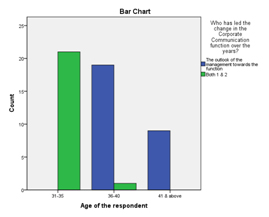
The findings of the above graph correspond with the results of the previous chart. The graph indicates that out of the total respondents, 56% feel that the management’s outlook towards the communications function has led to the change in corporate communications. Out of this lot, 95% belong to the age group 36-40 years and 100% of the age group 41 & above. Similarly, 44% of the respondents have attributed both the individual and the management for the change in the function. 95.5% of this lot belongs to the age group of 31-35 years.
The researcher, therefore, observes that the senior section of the communication team feels that the management’s outlook has led the change. In contrast, professionals who are a part of the middle management team feel that both the individual and the administration are responsible for this change.
- Functions of Corporate Communications
Graph 5.8(a)

In the above graph 96% of the total respondents suggest that the function of Corporate Communication includes media relations, employee communication, marketing communication, investor communication, website management, corporate affairs, social media activations, and corporate social responsibility. Only 4% of the total respondents feel that Corporate Communications means only media relations.
What started as a mere Public Relations function now caters to various verticals, not just a particular function.
Hence from the above findings, it can be observed that Corporate Communications includes a diverse portfolio and does not imply only a single function.
Graph 5.8 (b)
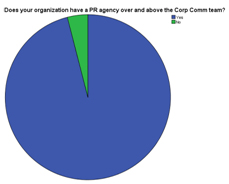
96% of the total respondents in the above graph say that they have also commissioned a P.R. agency over and above the communication department. Studies show that companies need P.R. agencies as an external interface of the organization with the outside world apart from their in-house communication team and add more value to their corporate reputation program.
5.9 Is digital media the new game-changer in Corporate Communication function?

The findings of the above-mentioned graph indicate that 56% of the total respondents feel that digital media is the new definition of corporate Communication, whereas 44% are not sure about the same.
According to several studies, social media marketing is a revolutionary communications technology that has quickly revolutionized Public Relations and has become a vital aspect of Corporate Communications for many businesses.
Besides the above-mentioned findings, the researcher also observed that respondents feel a significant amount of change has happened in corporate Communication as a function. But when it comes to the evolution of the function in the private sector vis-à-vis the M.N.C.s, 58% feel that the function is more evolved than the M.N.C.’s compared to the private sector companies in India. 98% of the respondents think that the organizational culture affects the function’s growth within any setup.
Findings:
Research findings indicate that the organization determines the change and process ofCorporate Communication within the private sector and is more influential than the individual in determining the overallframework. With the changing dynamics of the corporate communication function, the research findings prove that the function has evolved drastically, especially in the last five years. The management buy-in is instrumental in the growth from a traditional communications model to a full-fledged function.
The research findings prove that corporate communications are instrumental in organizational change. Themodern-day corporate sector’s senior management recognises this function’s importance in organizational change.
It was observed that organizational culture affects the growth of corporate Communication within any setup. Hence, the leadership team’s role becomes imperative for developing this function. The findings tell that the perception of the function remains the critical challenge of the corporate communication function. However, there has been a shift in the needle about the perception of the function. Still, the overall view on the function remains one of the critical challenges of corporate Communication. The performance of corporate communications depends heavily on the perceptions, beliefs, and expectations that chief executive officers (C.E.O.s) and other top executives hold towards Communication and its contribution to organizational goals.
The researcher believes that the advent of social media platforms is the new future of corporate communications. Companies worldwideuse social media for various purposes, including customer service, marketing, internal communications, public relations, and corporate social responsibility. Social media alters the way stakeholders and businesses communicate regularly, allowing for collaboration, participation, interactivity, and engagement.
Conclusion:
Changing business landscape and increasing focus on external stakeholder management have amplified Corporate Communication’s role within the private sector in India. To summarise, many private sector firms have begun to combine various communication disciplines under a single department, allowing practitioners’ knowledge and abilities to be shared and corporate Communication to be recognized as a self-contained and essential role inside the organization. With the increased importance of Communication in business, the situation (P.R.) has changed fundamentally in the private sector. P.R. has transformed itself and rechristened as Corporate Communication. The historical roles of manager and technician in corporate communications are lately evolving into a third role – the role of a “strategist.
The study also concludes that management’s outlook affects the growth of corporate Communication the most. It further reaffirms that management buy-in is one of the most important organizational traits for corporate communication development. Our research further concludes that the individual and the managementare equally responsible for the changes in the corporate communications function in the current scenario.
This research further infers that digital media is the new definition of corporate Communication,and social media marketing has become an integral part of corporate communications for many companies. Social media offers public relations practitioners’new options for every aspect of the corporate communications process.
The study also reveals that though there are well-defined KRA’s for each member in their team, quite often, these professionals have to perform tasks unrelated to their KRA – integrating them further into marketing, H.R., and other support functions. This has therefore led to the diversification of the Corporate Communications portfolio.
References:
- Benita Steyn. (2002). From ‘Strategy’ to ‘Corporate Communication strategy: conceptualization.
- Laura Matthews. (2010). Social Media and the Evolution of Corporate Communications, Volume 1, No. 1
- Richard R. Dolphin. (2000) Is Corporate Communications A Strategic
- Corporate Communications: An international journal, Volume 18, Issue 2
- Paul Argenti. (2013). Corporate Communication, 6th edition
- Joep Cornelissen. (2004) Corporate Communication: A Guide to Theory and Practice Kindle Edition.
- RossellaGambetti, Stephen Quigley. (2012). Managing Corporate Communication.
- AnsgarZerfass. (2014). Corporate communications from the C.E.O.’s perspective: How top executives conceptualize and value strategic Communication.
- Elif Karaosmanoglu. (2006). Corporate communications, identity, and image: a research agenda.
- David Michaelson. (202). Evaluating Efficacy in Public Relations/Corporate Communication Programming. Public Relations Journal Vol. 6, No. 5.
- 2010 Employee Communications Survey.The future of corporate communications. Corporate Communications benchmarking study
- Jeremiah Owyang. (2011). Three trends in Corporate Communications
- Karen S. Johnson. What Is the Importance of Corporate Communication?
- Susan Laws. (2014. Corporate Communication in the twenty-first century.
- Michael B. Goodman, Peter B. Hirsch. (2010). Corporate Communication: Strategic Adaptation for Global Practice
- J.L.Elving. (2010). Trends and developments within Corporate Communication.
[1]Director – Marketing & Branding, Lumnenore – A Netlink Platform, Jagran School of Journalism and Communication, Email- ksundaram@lumenore.com

